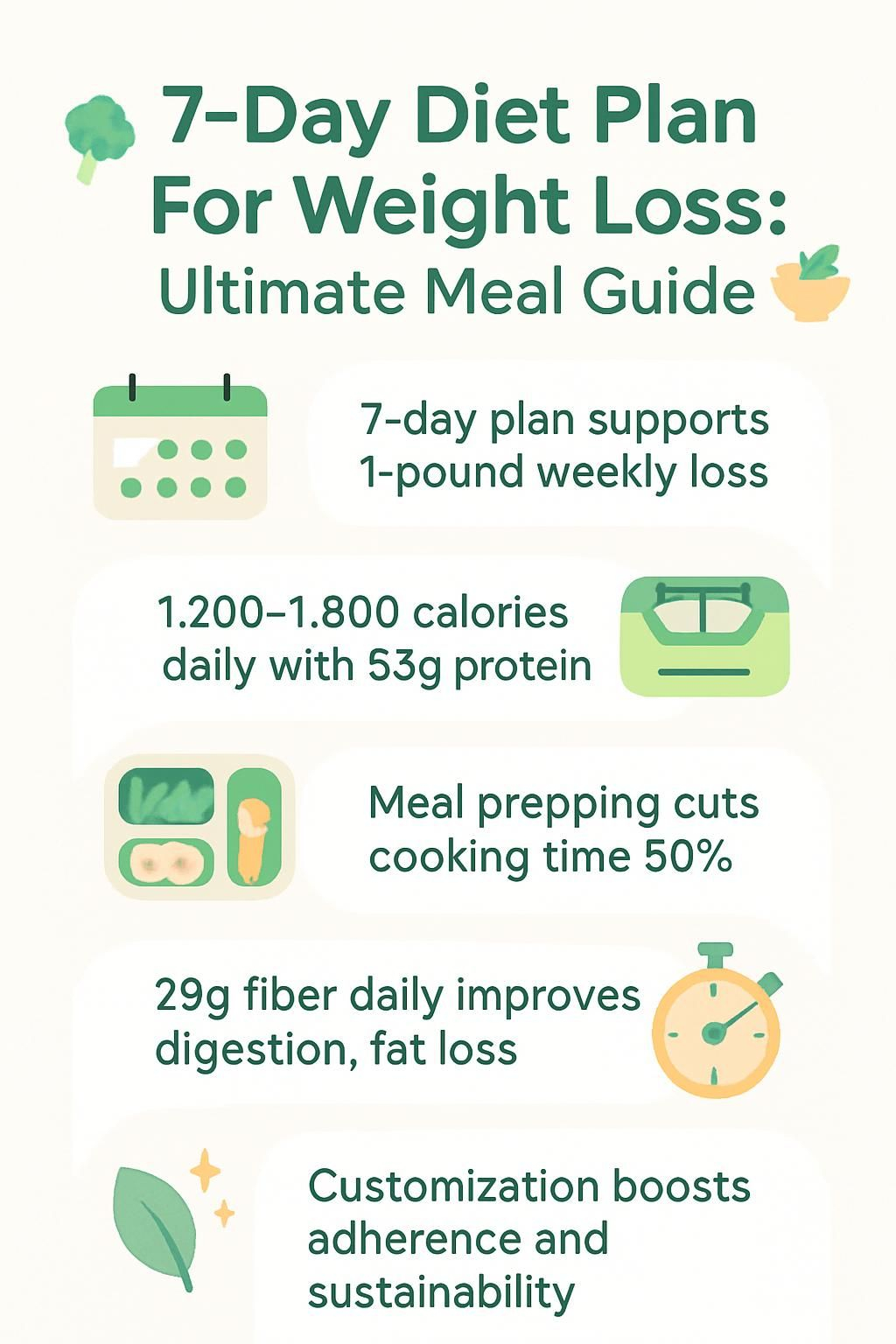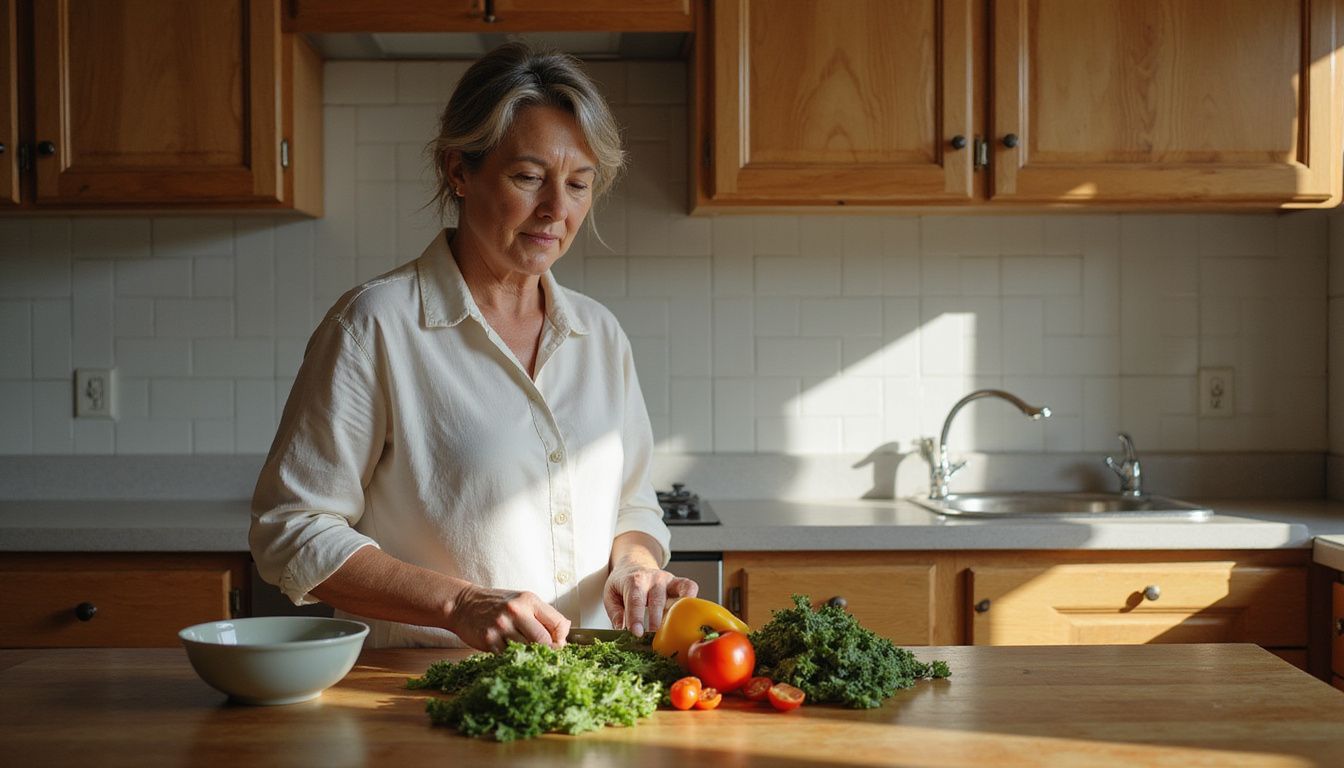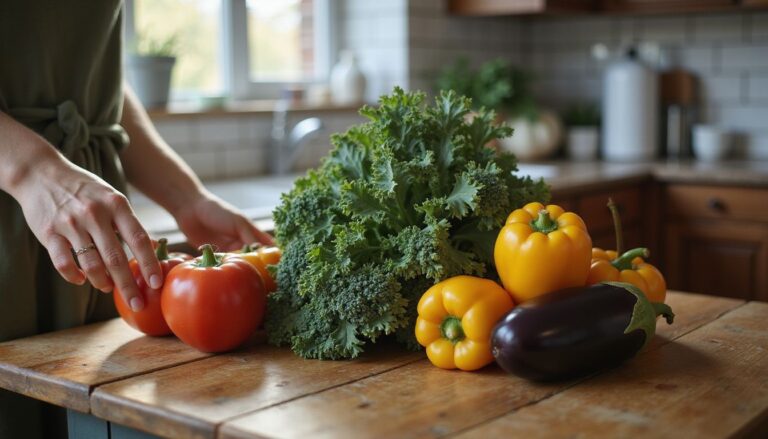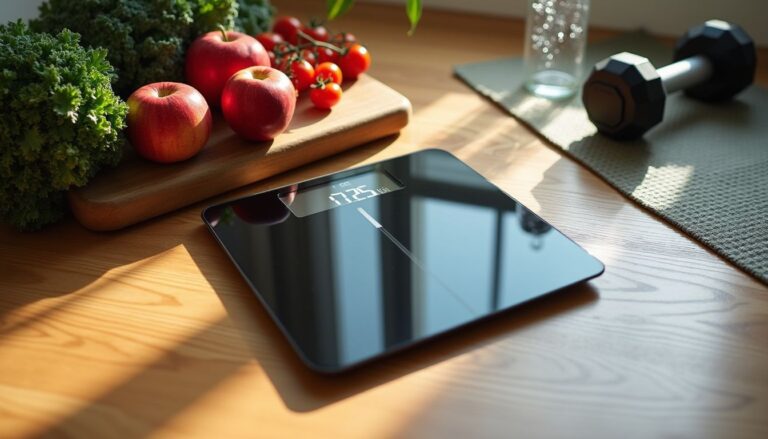7-Day Diet Plan For Weight Loss: Ultimate Meal Guide
Our Nutrition Assistant AI Suite will transform your body. You will lose fat, get toned, and build muscle. Gain confidence and optimal health.
Many people want a simple diet plan for weight loss that feels realistic and steady. I noticed how common this struggle is after learning that more than half of adults try losing weight each year. That pushed me to study what works and what lasts.
My 7-day meal plan offers clear meals, calorie ranges, and smart swaps approved by dietitians. Each day uses balanced foods you can find in any store. You can start with small steps, stay full, and still make progress.
Curious how one week can jump-start change? Keep reading to see how the plan fits your life.
Key Takeaways
- Following a 7-day meal plan with 1,200 to 1,800 calories per day and at least 58 grams of protein can support about one pound of weight loss each week.
- Meals focus on lean protein, whole grains, fruits, vegetables, and healthy fats like olive oil or nuts to protect muscle and curb hunger.
- Prepping meals in advance can cut daily cooking time by up to 50 percent. Store foods at or below 40°F to keep them fresh for up to four days (USDA).
- A high-fiber pattern with at least 29 grams per day supports regular digestion and reduces visceral fat risk, based on the 2020 to 2025 Dietary Guidelines for Americans.
- Adjusting the plan for your needs makes it easier to stick with long term (Academy of Nutrition and Dietetics, 2022).

Basics of a 7-Day Diet Plan for Weight Loss

A 7-day plan gives structure to daily choices and limits guesswork. I use it to build a balanced diet, control portions, and stay consistent without feeling boxed in.
How does a calorie deficit help you lose weight?
Eating fewer calories than your body burns creates a calorie deficit. Your body then uses stored fat for energy, which helps reduce both total fat and visceral fat, the deeper belly fat linked with higher health risks.
Research suggests pairing exercise with calorie control can trim about 1,000 calories per week, which helps target belly fat and supports heart health.
A weekly deficit near 3,500 calories can equal about one pound of weight loss.
I tracked daily intake between 1,200 and 1,800 calories using this plan. Lean proteins such as chicken breast or tuna with vegetables and whole grains kept me full and steady. Counting portions let me see progress without feeling restricted.
Why is balanced nutrition important for weight loss?
Balanced meals meet nutritional needs while creating a calorie gap for fat loss. I do best with at least 58 grams of protein and about 29 grams of fiber per day. That mix helps me feel full longer and snack less.
Antioxidant-rich foods like fruits, vegetables, legumes, whole grains, nuts, and seeds support metabolism and reduce oxidative stress. Vitamins C and E and beta carotene protect cells while I cut calories. Choosing nutrient-dense foods also helps preserve muscle as the scale moves down.
Essential Foods in the 7-Day Diet Plan
I build each day with foods that are easy to prep and keep me satisfied. These staples make the 7-day meal plan easier to follow.
What are the benefits of lean proteins?
Lean proteins such as chicken, turkey, shrimp, salmon, tofu, and eggs help me stay full. Getting at least 58 to 60 grams of protein per day supports muscle and appetite control during a diet meal plan.
I aim for a palm-sized serving of protein at meals. That keeps hunger in check and makes a calorie deficit easier to maintain. Lean options such as chicken salad or baked salmon are lower in added sugar and saturated fat than many processed meats.
How do whole grains support weight loss?
Whole grains like brown rice, quinoa, oatmeal, and whole-wheat toast provide complex carbohydrates. These carbs digest slowly and deliver steady energy.
Fiber in whole grains supports digestion and helps me feel full for hours. Research links three servings of whole grains per day with less belly fat gain over time. A cup of cooked quinoa at lunch keeps afternoon cravings down for me.
Why include fruits and vegetables in your diet?
Fruits and vegetables add fiber, water, vitamins, and minerals with few calories. I often add a cup of berries at breakfast or serve steamed broccoli with dinner for a nutrient boost.
They also deliver antioxidants like beta carotene that fight inflammation and protect cells. High-fiber choices such as spinach, broccoli, and leafy greens help reduce bloating and keep me full. I rotate different colors each day for broader coverage.
What are healthy fats and why do you need them?
Healthy fats such as avocado, olive oil, nuts, and seeds help control hunger and support heart health. I usually include 60 to 76 grams per day, based on dietitian guidance and my calorie target.
Simple additions work well, like olive oil on roasted vegetables or nut butter on whole-grain toast. These fats make meals satisfying, which keeps me consistent through the week.
Day 1 Meal Plan
I start day 1 with lean protein and fiber-rich produce. Simple combinations make it easier to stay on track.
What is a healthy breakfast option for day 1?
I like 3/4 cup bran flakes with one sliced banana and one cup fat-free milk. The cereal gives whole grain fiber, the banana adds potassium and sweetness, and the milk provides protein and calcium.
If I want a warm option, I cook one cup of oatmeal. I stir in one tablespoon almond butter and half a banana. Oats support healthy cholesterol, and the nut butter adds satisfying fat.
What should I eat for lunch on day 1?
A mini whole-wheat pita with 3 ounces turkey breast, half a roasted pepper, and lettuce makes a filling lunch. I mix one teaspoon mayonnaise with mustard for flavor.
I add one part-skim mozzarella string cheese for more protein and calcium. Two fresh kiwis bring vitamin C and natural sweetness. For a Mediterranean twist, I sometimes use hummus, red peppers, chickpeas, and olives in a Niçoise-style pita. Each serving stays near 290 calories.
What is a nutritious dinner for day 1?
I enjoy 4 ounces of flounder seasoned with lemon and herbs, about 200 calories. I serve it with one cup cooked couscous and one cup steamed broccoli for fiber and micronutrients.
A single-serve ice cream can fit for dessert without breaking the budget. This balanced dinner supports weight loss while keeping the menu satisfying.
Day 2 Meal Plan
Day 2 uses quick recipes with whole grains and extra vegetables. Small prep steps keep the day simple.
What is a good breakfast for day 2?
I blend one cup frozen berries, half a banana, and eight ounces low-fat or fat-free milk for a smoothie. It gives antioxidants, protein, and fiber.
One or two hard-boiled eggs add more protein and keep me full until lunch.
What lunch choices are best for day 2?
I pair one cup vegetable soup with a veggie burger on whole-grain toast or an English muffin. The burger brings protein without much fat, and whole grains boost fiber.
One cup of grapes makes an easy side for hydration and antioxidants. This mix supports steady energy through midday and keeps calories in range.
What dinner fits the day 2 meal plan?
Barbecue cutlets with citrus slaw make a flavorful, lower-calorie dinner, about 265 calories per serving. The slaw adds crunch and vitamin C.
If I want something lighter, I sauté spinach with garlic, onions, tomatoes, and a little olive oil. A half baked potato or sweet potato adds fiber and makes the meal more filling.
Day 3 Meal Plan
Day 3 keeps the focus on fiber and lean protein. I plan easy meals that still feel fresh.
What can I eat for breakfast on day 3?
I cook 1/2 cup oats with low-fat milk or unsweetened soy milk. I top it with half an apple, a teaspoon of honey, and cinnamon for warm flavor.
Oats give slow energy and fiber. Apples add natural sweetness. Cinnamon may help support healthy blood sugar levels in some people.
What lunch options are healthy for day 3?
Chicken salad works well. I use 4 ounces shredded skinless chicken, 1/4 cup red grapes, 1 tablespoon slivered almonds, and 1/4 cup celery. I mix one tablespoon mayonnaise with one tablespoon Greek yogurt for a lighter dressing.
I serve it over fresh lettuce with a slice of multigrain toast. It offers lean protein, whole grains, and fruit in one plate.
What is a balanced dinner for day 3?
I eat 4 ounces steamed shrimp for lean protein. A baked potato adds complex carbs and fiber. I top it with salsa and a spoonful of Greek yogurt for taste without heavy fat.
Three cups of steamed spinach fill half the plate and add iron and vitamins. For dessert, I choose one ounce of chocolate or an ice cream bar under 150 calories.
Day 4 Meal Plan
On day 4, I build meals around corn, nuts, and cucumber for crunch and balance.
What breakfast should I have on day 4?
I choose one cup plain Greek yogurt with one cup berries. Sometimes I swap in 1/2 cup low-sugar granola plus the berries for more texture.
Greek yogurt is rich in protein and calcium. Berries add vitamin C and fiber. This bowl stays near 250 calories when measured.
What is a good lunch for day 4?
I start with one cup tomato soup. Then I fill a mini whole-wheat pita with 3 ounces roast beef, a little horseradish, mustard, tomato, and lettuce.
Two cups raw vegetables such as carrots and bell peppers round out the plate. I use 1/4 cup hummus for dipping to add healthy fats and flavor.
What dinner fits the day 4 plan?
I enjoy 4 ounces poached salmon with one cup cooked quinoa. For a side, I toss 1 1/4 cups coleslaw mix with two sliced scallions, one tablespoon rice vinegar, and 1 1/2 teaspoons olive oil.
This dinner brings in omega-3 fats, whole grains, fiber, and plenty of crunch. It keeps me satisfied without pushing me over my calorie target.
Day 5 Meal Plan
Day 5 adds new flavors, like feta and roasted squash, to keep the plan interesting.
What are breakfast ideas for day 5?
I pour one cup Cheerios, add 1/2 cup berries, and sprinkle one tablespoon slivered almonds. I serve it with six ounces plain Greek yogurt for extra protein.
This mix delivers whole grains, vitamin C, calcium, and healthy fats in one quick bowl.
What should lunch include on day 5?
Mushroom quesadillas are the main dish. I use whole-grain tortillas for fiber. Cucumber spears add hydration and vitamin K.
For more protein, I add 1/2 cup 2 percent cottage cheese or Greek yogurt. Two clementines finish the meal with vitamin C and a light sweetness.
What dinner options work for day 5?
Balsamic-glazed pork tenderloin is a strong choice at about 370 calories per serving. I pair it with roasted butternut squash for vitamin A, fiber, and potassium.
Lean protein supports muscle maintenance and fullness during weight loss. Roasted squash brings color and helps keep the meal satisfying.[1]
…
[1] National Institutes of Health (NIH): “Dietary Protein and Muscle Mass: Translating Science to Application” (2022)
Day 6 Meal Plan
Day 6 centers on simple recipes with lean protein, whole grains, and fresh produce.
What can I have for breakfast on day 6?
I toast a whole-grain frozen waffle and spread two tablespoons nut butter on top. I add one small sliced banana with cinnamon and a touch of nutmeg.
Eight ounces fat-free milk rounds out the plate. The combo brings fiber, protein, calcium, and potassium while keeping calories reasonable.
What are healthy lunch options for day 6?
Tuna salad is my main dish, about 135 calories per serving. I often stir in canned black beans for extra protein and fiber. A slice of whole-grain bread adds steady energy.
I fill the rest of the plate with 10 baby carrots and one cup steamed broccoli. A fresh pear adds natural sweetness and more fiber. Two-thirds cup plain Greek yogurt works if I want a creamy side.
What dinner suits day 6 of the plan?
Spicy sausage jambalaya fits well. I use lean sausage and brown rice for balanced macros and better fullness. Tomatoes and bell peppers bring antioxidants and color.
On the side, I sauté three cups spinach with garlic and one tablespoon olive oil. Spinach adds iron and vitamin K, and olive oil supplies healthy fats.
Day 7 Meal Plan
Day 7 wraps up the week with nutrient-packed meals so you finish strong.
What is a nutritious breakfast for day 7?
I toast half an English muffin and melt one ounce reduced-fat cheese over tomato slices. I add one cup steamed spinach and a poached egg for protein.
I eat one grapefruit for fruit and vitamin C. If I want more flavor, I use a small smear of mustard.
What lunch fits the day 7 meal plan?
I make a black bean salad with 1/2 cup canned black beans and 1/2 cup orange segments. I add bell peppers, onions, scallions, and crisp greens for color and crunch.
One stone-ground corn tortilla adds whole-grain carbs for steady energy. A piece of fruit on the side keeps me satisfied until dinner.
What should I eat for dinner on day 7?
Cajun-Spiced Tofu Tostadas with Beet Crema work well at about 432 calories. Tofu provides lean protein, and the tostada shells add whole-grain crunch. Beet crema offers extra fiber and vitamins.
I top them with shredded lettuce and chopped tomatoes. A small drizzle of mustard can boost flavor without many calories.
Tips for Preparing Ahead
Planning meals before the week starts reduces stress and helps me follow the plan. A little prep can shape better choices later.
How can meal prep save time?
Batch cooking snacks and salads saves hours. I pre-bake eggs in a muffin tin for quick breakfasts. Research shows making several meals at once can cut daily cooking time by up to 50 percent.
Freeing time in the kitchen also helps me focus on quality. Reheating a ready portion is faster than starting from scratch on busy days.
What is the best way to store meals for freshness?
I keep nuts and crunchy snacks in airtight containers to block moisture. For salads and cooked proteins, I use glass or BPA-free containers with tight lids. The USDA advises storing prepared foods at 40°F or below for up to four days.
I label each container with a date so I eat the oldest items first. Dividing large batches into single portions cools food faster and helps control portions across the week.
Benefits of Following the 7-Day Diet Plan
A one-week plan can build habits that last. Structure reduces guesswork, and balanced meals help energy stay steady.
How does this plan support sustainable weight loss?
Clear calorie targets, such as 1,500 per day, keep me focused. Lean protein and fiber manage hunger, which makes it easier to maintain a deficit without losing muscle.
After a week of planned meals, my cravings dropped and I felt more in control. The goal is a routine you can repeat, not quick fixes.
How can the plan improve your energy levels?
Balanced meals with whole grains, lean protein, and healthy fats deliver steady energy instead of spikes. Oats and brown rice release energy slowly. Fruits like apples provide natural sugars, and vegetables supply key vitamins for metabolism.
I noticed fewer afternoon slumps. Keeping blood sugar stable made my focus better throughout the day.
What health benefits come from following the plan?
This plan can reduce visceral fat, which supports heart health and lowers type 2 diabetes risk. Higher fiber intake, around 29 to 40 grams per day, improves digestion and helps prevent constipation.
Fruits and vegetables bring antioxidants that calm inflammation and protect cells. Regular, balanced meals built from nutrient-dense foods support healthy aging.
Frequently Asked Questions
Many people have similar questions before they start. Here are clear answers that can help you move forward with confidence.
Can I modify the meal plan for dietary restrictions?
Yes, I adjust foods to match my needs. For vegetarian days, I choose lentils or tofu instead of chicken. If I avoid wheat, I use brown rice or quinoa for grains.
Personalized plans often lead to better adherence and results. Experts encourage making swaps while keeping portions, calories, and balance in line.[1]
___
[1] Academy of Nutrition and Dietetics (2022). “Dietary Guidelines for Americans.”.
What healthy snacks can I include?
Orange slices, raspberries, and Greek yogurt with berries are easy picks rich in vitamin C, fiber, and probiotics. Pita with hummus or a banana with peanut butter gives steady energy.
Chile-lime peanuts offer protein with a kick. Mini bell peppers stuffed with white beans, or small guacamole jars with vegetables, are filling choices that travel well.
Conclusion
A structured 7-day meal plan makes losing weight feel manageable. Thoughtful meals help you stay energized, and a modest calorie deficit supports steady fat loss.
Lean proteins, whole grains, fruits, and vegetables keep meals filling and nutritious. If you have a medical condition, talk with a registered dietitian or your clinician before changing your eating plan. Start where you are, use the guide, and build habits you can keep.
FAQs
1. What is the main goal of a 7-day diet plan for weight loss?
A 7-day meal guide aims to help individuals reduce body fat by providing balanced nutrition and controlled calorie intake each day. Research shows that structured plans can improve adherence and support steady progress toward healthy weight targets.
2. How does the ultimate meal guide ensure nutritional balance during weight loss?
The plan includes lean proteins, whole grains, fruits, vegetables, and healthy fats in every daily menu. This approach helps maintain muscle mass while promoting fat loss; it also supplies essential vitamins and minerals needed for overall health.
3. Can I personalize this 7-day diet plan based on my preferences or dietary needs?
Yes; you can adjust meals to fit vegetarian diets or food allergies as long as you keep total calories within recommended limits for your goals. Studies suggest that personalizing meal choices increases satisfaction and supports long-term success.
4. Are there any scientific studies supporting short-term diet plans like this one?
Several clinical trials have found that following a structured weekly eating schedule leads to greater initial weight reduction compared with unplanned eating patterns. For example, research published in Obesity Reviews highlights improved outcomes when participants follow clear guidelines over seven days.
Summary: A well-structured weekly meal guide uses evidence-based strategies to promote safe fat reduction while meeting nutritional requirements through varied foods tailored to individual needs.







